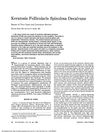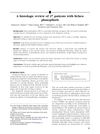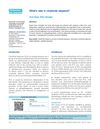TLDR A 12-year-old boy's hair loss and skin issues improved significantly with medication.
The document described a case of lichen planopilaris, a type of scarring alopecia, in a 12-year-old boy who experienced progressive patchy hair loss on the scalp, accompanied by dusky blue eruptions on the upper lip and eyebrows. Examination revealed plaques of alopecia with smooth, shiny, atrophic skin and erythema, along with erythematous, scaly, follicular papules. Histological analysis showed hyperkeratosis, hypergranulosis, and a band-like lymphohistiocytic infiltrate. Treatment with ultramicronized griseofulvin and prednisolone for 6 months, supplemented with topical betamethasone dipropionate, resulted in an excellent response, with a noticeable decline in the inflammatory infiltrate.
 54 citations
,
January 1983 in “Archives of Dermatology”
54 citations
,
January 1983 in “Archives of Dermatology” KFSD is a rare condition causing scarring hair loss, with no effective treatment known at the time of the report.
 13 citations
,
April 2001 in “International Journal of Dermatology”
13 citations
,
April 2001 in “International Journal of Dermatology” Different types of scarring alopecia may be stages of one disease, and accurate diagnosis is crucial to prevent permanent hair loss.
 76 citations
,
June 2008 in “Journal of the American Academy of Dermatology”
76 citations
,
June 2008 in “Journal of the American Academy of Dermatology” The conclusion is that certain scalp tissue changes are characteristic of lichen planopilaris, with mucinous perifollicular fibroplasia being a new feature for diagnosis.
 16 citations
,
January 2013 in “Indian Journal of Dermatology, Venereology and Leprology”
16 citations
,
January 2013 in “Indian Journal of Dermatology, Venereology and Leprology” New treatments and early diagnosis methods for permanent hair loss due to scar tissue are important for managing its psychological effects.
 1 citations
,
April 2010 in “Expert Review of Dermatology”
1 citations
,
April 2010 in “Expert Review of Dermatology” The document concludes that early diagnosis and treatment are crucial for managing rare hair loss disorders and that more research is needed to improve treatment strategies.
 98 citations
,
May 2008 in “British Journal of Dermatology”
98 citations
,
May 2008 in “British Journal of Dermatology” There are many treatments for permanent hair loss disorders, but their effectiveness varies and there's no clear best option.






